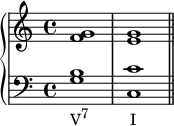
Dominant seventh chord
In music theory, a dominant seventh chord, or major minor seventh chord,[a] is a seventh chord, composed of a root, major third, perfect fifth, and minor seventh. Thus it is a major triad together with a minor seventh, denoted by the letter name of the chord root and a superscript "7".[3] In most cases, dominant seventh chord are built on the fifth degree of the major scale. An example is the dominant seventh chord built on G, written as G7, having pitches G–B–D–F:
It's important to notice that the leading note and the subdominant note combined form a diminished fifth (tritone). The clashing sounds produced by playing these two notes together gives the dominant seventh chord its dissonant quality (i.e, lack of harmony, or its instability).[4]
Dominant seventh chords are often built on the fifth scale degree (or dominant) of a key. For instance, in the C major scale, G is the fifth note of the scale, and the seventh chord built on G is the dominant seventh chord, G7 (shown above). In this chord, F is a minor seventh above G. In Roman numeral analysis, G7 would be represented as V7 in the key of C major.
Similarly, this chord also occurs on the seventh degree of any natural minor scale (e.g., G7 in A minor).
The dominant seventh is perhaps the most important of the seventh chords. It was the first seventh chord to appear regularly in classical music. The V7 chord is found almost as often as the V, the dominant triad,[5] and typically functions to drive the piece strongly toward a resolution to the tonic of the key.
A dominant seventh chord can be represented by the integer notation {0, 4, 7, 10} relative to the dominant.


